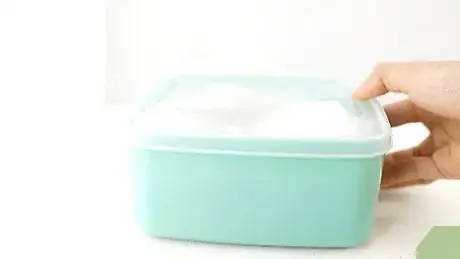This article was co-authored by wikiHow staff writer, Eric McClure. Eric McClure is an editing fellow at wikiHow where he has been editing, researching, and creating content since 2019. A former educator and poet, his work has appeared in Carcinogenic Poetry, Shot Glass Journal, Prairie Margins, and The Rusty Nail. His digital chapbook, The Internet, was also published in TL;DR Magazine. He was the winner of the Paul Carroll award for outstanding achievement in creative writing in 2014, and he was a featured reader at the Poetry Foundation’s Open Door Reading Series in 2015. Eric holds a BA in English from the University of Illinois at Chicago, and an MEd in secondary education from DePaul University.
There are 7 references cited in this article, which can be found at the bottom of the page.
The wikiHow Video Team also followed the article's instructions and verified that they work.
This article has been viewed 29,871 times.
Learn more...
A delicious, crispy egg roll is a phenomenal treat. Unfortunately, if you don’t eat them all in one sitting, the oil in the wrapper and the moisture in the fillings can cause the fried rice paper wrapping to become soggy and unappealing. If you’re making them from scratch, the best way to keep egg rolls crispy and delicious is to avoid unnecessary oils and remove the excess moisture in the ingredients. For store-bought egg rolls, there are several ways to keep the oil and moisture from getting out of hand.
Steps
Cooking Your Egg Rolls
-
1Keep the ingredients dry before making egg rolls from scratch. After washing your veggie fillings, wipe all of the water off with a paper towel before cutting the vegetables. Once cut, wrap your fillings in another paper towel and squeeze them to wring the moisture out. If you’re using any meat fillings, squeeze the moisture out with a paper towel after cooking and cutting the ingredients.[1]
- The more moisture you can remove from the ingredients, the more likely the egg roll wrapper will stay dry when cooking and storing the egg rolls.
-
2Avoid adding oils to store-bought egg rolls. For frozen rolls, there is almost always enough oil in the wrapper already. Do not add any sesame oil, soy sauce, or vegetable oil to your egg rolls before cooking them. This may feel counterintuitive, but egg roll wrappers have plenty of oil built into them to begin with and adding more can lead to soggy egg rolls.[2]
Tip: This can also be relevant for homemade egg rolls. While you do need to use some oils to make them, try to keep the liquids to a minimum. If you’re deep-frying them, they’ll be submerged in oil anyway, so there’s no need to add more.
Advertisement -
3Cool your rolls on a wire rack instead of a paper towel or plate. Regardless of whether you air fried, deep-fried, or baked your egg rolls, do not let them cool on a paper towel or plate. Instead, use a pair of tongs to set the egg rolls on a raised cooling rack with a baking sheet underneath it. This way, the oils won’t build up at the base of the egg roll and will drip freely to the baking sheet below.[3]
- If the oils build up in the base of the wrapper, your egg rolls will only feel partially crispy and the wrapper at the bottom of each egg roll will feel soggy.
-
4Go light on the sauces if you want to reheat the rolls later. Do not douse your egg rolls in sauce before serving them. Instead, let people dip their egg rolls as they desire. Storing egg rolls that already have sauce on them is exceptionally hard and the sauce is extremely likely to make them soggy when you reheat them.[4]
- If you’re storing any sauces for your egg rolls and you’re putting the rolls in the fridge, do not package them together. The rolls may absorb some of the moisture from the sauces.
Storing Your Egg Rolls Correctly
-
1Line a well-ventilated container with a paper towel for fridge storage. You should not use an airtight container to store your egg rolls in the fridge since the moisture inside of each roll needs air to dissipate. Get a well-ventilated container for your egg rolls. Line the bottom of your storage container with 2-3 paper towels to absorb any oil from your egg rolls.[5]
- A takeout container or Styrofoam container with 3-5 holes punched it in is perfect for this.
Variation: If you don’t have a good container for this, use an airtight storage container and don’t close the lid all the way. Leave a 1⁄2–1 in (1.3–2.5 cm) gap between the container and the lid to give the rolls room to breathe.
-
2Line your egg rolls on the paper towel in a single layer. Do not stack your egg rolls and leave as much space between the individual rolls as possible. Lay your egg rolls flat on the bottom of your container.[6]
- The more room your egg rolls have, the more evenly the egg rolls will dry out in the fridge.
-
3Store your egg rolls in the fridge for 2-3 days. You can keep your egg rolls in the refrigerator for 2-3 days before they start to go bad. The earlier you can eat them, the better. The filling won’t be nearly as crispy after 1-2 days.[7]
- You cannot store cooked egg rolls in the freezer without turning them into a soggy mess. You can store uncooked egg rolls in the freezer, though!
- The refrigerator is really the only option when it comes to storing cooked egg rolls. Unfortunately, they just aren’t great dishes when it comes to long-term storage.
-
4Store uncooked vegetarian egg rolls in the freezer with flour or cornstarch. If you’re making egg rolls from scratch and you prepared too many of them, you can store them in the freezer for 2-3 months. Get an airtight plastic food container and sprinkle flour or cornstarch along the bottom of the container. Add your uncooked rolls in a sequence of parallel rolls and columns. Sprinkle more flour or cornstarch on top before adding another layer. Close the container and set it in your freezer.[8]
- You can only do this if your egg rolls do not have meat in them. When you thaw the egg rolls or cook them, the meat won’t come out particularly well since it’s already been cooked.
Reheating Egg Rolls on a Skillet
-
1Heat a non-stick skillet over low heat for 5-10 minutes. Get a clean, nonstick skillet and set it out on your stove. Heat the skillet for 5-10 minutes to warm the skillet up. The goal here is to cook your egg rolls as quickly as possible to avoid giving the moisture and oils time to soak into the wrapper as the rolls reheat, so a warm skillet will help this process along.[9]
Warning: There is no faster way to ruin perfectly good egg rolls than to reheat them in the microwave. The wrapper will become a strange combination of soggy and brittle. Do not reheat rolls in the microwave!
-
2Place your cold egg rolls in a single layer on the skillet. Take your egg rolls out of the refrigerator and place them flat on the bottom of your skillet. If your egg rolls don’t feel oily or slick, pour 1 teaspoon (4.9 mL) of olive oil into your warm pan. Arrange your egg rolls in a single layer on the skillet.[10]
- If you hear a little sizzling, this is a good sign that you’re on the right track towards reheated rolls with a crispy snap to them.
-
3Heat your egg rolls for 3-5 minutes. Let your egg rolls heat on one side for 3-5 minutes. If you see the egg rolls start to smoke in the pan, rotate them and turn them over to keep them from burning. Egg rolls aren’t particularly thick, so they don’t need a ton of time on the skillet to reheat.[11]
-
4Flip the egg rolls over and cook them for an additional 3-5 minutes. Use a pair of tongs to grab each egg roll and flip them over to cook on the opposite side. Reheat the second side for 3-5 minutes before transferring your egg rolls to a plate. If you like really crispy egg rolls, rotate them again 2 additional times for 1-2 minutes each before plating your egg rolls.[12]
- If the egg rolls look like they absorbed too much oil, set them on a paper towel to dry them off before plating them.
- To tell if the egg rolls are done, poke them with your tongs. If the skin is hard but there’s a slight give to the rolls, they’re done
Warming Egg Rolls up in the Oven
-
1Preheat your oven to 350 °F (177 °C) and prepare a baking sheet. Your egg rolls will come out perfectly crispy in the oven as well. Set your oven to 350 °F (177 °C). While you’re waiting for the oven to preheat, line a baking sheet with aluminum foil. Set the egg rolls on top of the baking sheet so that no egg roll is overlapping.[13]
- You do not need to line the aluminum foil with cooking spray. The fried wrapper shouldn’t stick to the pan when you pull them out. The egg rolls will be less crispy if you do this as well.
-
2Set your sheet in the oven and heat the egg rolls for 10-15 minutes. Once your oven is preheated, slide the baking sheet into the center rack. Set the timer for 10-15 minutes depending on how cold the egg rolls were when you took them out of the fridge. If they were hard and really cold to the touch, 15 minutes is likely appropriate. If they were only moderately cold, 10 minutes should get the job done.[14]
- You can cook them a little longer if you like your egg rolls extra crispy!
-
3Take the sheet out of the oven and enjoy your egg rolls. Once the egg rolls have reheated, put on an oven mitt and slide the pan out of the oven. Set it on top of your stove and use tongs to lift the egg rolls off and set them on a plate.[15]
- If they look oily or moist, set the egg rolls down on a paper towel and blot them dry with a separate paper towel to remove the excess oil.
Things You’ll Need
Cooking Egg rolls Differently
- Paper towels
- Wire rack
Storing Your Egg rolls Correctly
- Storage container
- Paper towel
- Cornstarch or flour
Reheating Egg Rolls on a Skillet
- Non-stick skillet
- Tongs
- Plate
- Paper towel (optional)
Warming Egg Rolls up in the Oven
- Baking sheet
- Aluminum foil
- Tongs
- Paper towel (optional)
References
- ↑ https://steamykitchen.com/13029-chinese-egg-rolls-recipe.html
- ↑ https://kitchen.casaveneracion.com/how-to-reheat-fried-spring-rolls/
- ↑ https://www.thekitchn.com/the-best-way-to-keep-fried-foods-crispy-tips-from-the-kitchn-217544
- ↑ https://steamykitchen.com/13029-chinese-egg-rolls-recipe.html
- ↑ https://onthegas.org/the-kitchen-hand/how-to-keep-fried-food-crispy
- ↑ https://onthegas.org/the-kitchen-hand/how-to-keep-fried-food-crispy
- ↑ https://onthegas.org/the-kitchen-hand/how-to-keep-fried-food-crispy
- ↑ https://kitchen.casaveneracion.com/how-to-store-uncooked-spring-rolls/
- ↑ https://www.thebestestever.com/best-way-to-reheat-an-egg-roll.html
- ↑ https://www.thebestestever.com/best-way-to-reheat-an-egg-roll.html
- ↑ https://www.thebestestever.com/best-way-to-reheat-an-egg-roll.html
- ↑ https://www.thebestestever.com/best-way-to-reheat-an-egg-roll.html
- ↑ https://www.thebestestever.com/best-way-to-reheat-an-egg-roll.html
- ↑ https://www.thebestestever.com/best-way-to-reheat-an-egg-roll.html
- ↑ https://www.thebestestever.com/best-way-to-reheat-an-egg-roll.html
- ↑ https://food.unl.edu/keeping-foods-warm-while-other-foods-get-done


























































